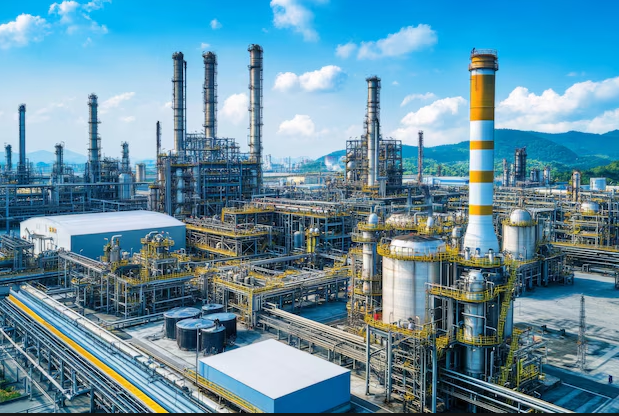At a Glance
CO2 emissions have been one of the biggest concerns for all industries in the world and, of course, the chemical industry is no exception. Carbon mitigation initiatives are becoming increasingly important drivers of growth for the chemical industry as demand for more sustainable practices grows. Since the chemical industry is well known for heavy emission activities, it must manage CO2 emissions which challenge profitability. This blog post discusses the effects of emissions reductions on the chemical industry, and the role of carbon emissions, and shows how companies can achieve sustainability goals while expanding.
The biggest source of CO2 emissions is the chemical industry because its big production processes in plastics, fertilizers, and petrochemicals rely on fossil fuels. Therefore, these huge processes put a heavy hand on the global CO2 emission levels. However, this landscape is changing. Industries and governments around the world push for more sustainable practices that might just stop climate change.
Carbon reduction has now become not only a legal obligation but also a source of competitive advantage in the chemical industry. With increasing environmental standards pressure and growing demand for green products, there is an increased call on chemical companies to invest in technologies and practices that significantly bring down the carbon footprint of the respective activities conducted by them. This move towards sustainability is not only environmentally beneficiary but also fosters strong long-term positioning within the market of the industry.
Carbon Emissions in the Chemistry Industry: Importance
The carbon footprint of the chemical industry derives mainly from the reliance on intensive-energy processes. Whether it be the production of base chemicals, such as ethylene or speciality chemicals used in the manufacture of pharmaceuticals and agricultural products, energy input in these plants is immense, therefore significantly contributing to CO2 emissions. Based on recent reports, the chemical industry consumes approximately 10% of industrial energy worldwide and a similar percentage of the source of global CO2 emissions.
Distribution of Carbon Emissions by Source
Key carbon-emitting sources within the chemical industry include the following:
- Fossil fuel burning: This is one of the chief energy sources used in fossil fuel burning, which releases most of the CO2 emissions from chemical plants.
- Chemical reaction: In some chemical manufacturing processes, carbon escapes as part of the reaction, for example, ammonia or cement.
- Transportation: There is carbon emission from raw materials and finished products in transportation.
Despite all these problems, the chemical industry in recent times has been trying to reduce its carbon footprint through new technologies, energy-efficient designs, and gradually greener alternatives.
Carbon Emission Reduction Strategies in the Chemical Industry

The future of the chemical industry involves a drive toward carbon mitigation. Different strategies have been used to cut down on emissions and reach sustainability goals worldwide.
- Energy Efficiency Improvement
One of the most obvious means of reducing carbon is through energy efficiency. It can be achieved through the improvement of existing equipment, optimization of processes, and more energy-efficient technologies. For this reason, companies can reduce their consumption of energy and, as an indirect effect, their emissions. For instance, in chemical plants, heat integration allows for energy recovery and its subsequent use, with the implication being lesser energy consumption.
- Carbon Capture and Storage (CCS)
Another new technology that such chemical companies can use to reduce emissions is carbon capture and storage. In this technology, CO2 is captured before emission and usually stored underground or used for other industrial processes. This allows for the continuation of chemical plants’ operation but with lower impacts on the surroundings.
- Use of Renewable Energy
Shifting towards renewable energy is the most essential step for the chemical industry to reduce carbon in the future. Companies have been encouraged to invest even more in renewable energy such as solar, wind, and bioenergy. As a result, CO2 emissions by source are reduced due to less dependence on fossil fuels. Chemical companies are increasingly incorporating renewable energy into their business processes through investments in renewable energy generation on-site or through third-party purchases of green energy.
- Green Chemistry and Sustainable Manufacturing
The principles of green chemistry make it possible to design a chemical process which avoids or generates less hazardous substances. Chemical companies can reduce their environmental impacts by using more sustainable materials and processes. Replacing conventional solvents with safer, less toxic alternatives can reduce CO2 emissions but also minimize risks to health and the environment.
- Process Optimization and Digitalization
Digital technologies and automation are making it possible for manufacturers of chemicals to hone their processes by perceiving what is happening around them through machine learning, AI, and predictive analytics. This allows the company to better monitor energy use, optimize schedules, and improve overall efficiency. By pinpointing priority areas with the right data and insights, chemical plants will identify areas that need improvement in real-time solutions to reduce emissions.
Carbon Reduction in Industrial Development
While carbon emission-reduction measures can be expensive and complicated to undertake, in the long term, they become growth triggers. Companies embracing sustainable practices position themselves as market leaders in this ever-evolving market. Companies with strong sustainability initiatives are gaining attention from consumers, investors, and regulatory bodies.
- Improvement in Efficiency and Profitability
It is one of the most effective, yet cost-effective methods of reduction in carbon, and chemical companies also derive benefits, such as lower operation costs, from better energy use and fewer wastes produced through improvements in the efficiency of energy use. Carbon capture and renewable energy technologies may lead to long-term savings.
- New Markets and Investment
Companies that are leading by reducing their carbon footprint also have advantages in new markets. For example, many regions, such as the European Union, have introduced carbon taxes and emissions trading systems, which favour companies with lower carbon footprints. Furthermore, more investors are increasingly seeking to finance companies targeted to meet global sustainability goals. Reductions in emissions form the base of a chemical company’s ability to open up new funding opportunities and win environmentally sensitive consumers.
- Regulations and Competitive Advantage
Governments worldwide are establishing more stringent regulations for CO2 emissions, and the chemical industry is no exception. Companies that will actively reduce carbon footprints will be in a good position to match potential regulations and avoid fines and penalties. More so, those consumers with environmental concerns will look out for companies that make sustainability a crucial part of their business strategy first.
Overcoming The Challenges of Carbon Emissions Hurdles
Although a great deal of potential lies in the carbon mitigation push, there are challenges as well. One major challenge is the high upfront cost to initiate new technologies and processes. The incentives of the government and long-term efficiency savings, however, offset these costs.
The second problem would arise from the retrofitting of existing facilities with new emission-reducing technologies. Many chemical plants are highly integrated and large. Change of this dimension requires significant alteration to infrastructure on a major scale, which may deter investment. However, many companies are finding that the long-term benefits of carbon mitigation far outweigh this initial investment.
Conclusion
The chemical industry is at a crossroads, where the issue of sustainability is urgent for imperative change. Carbon mitigation is a necessity not only for environmental protection but also to ensure the long-term growth of the sector. Yet, by embracing new technologies and enhancing efficiency and integration of renewable energy, the chemical industry can really make drastic reductions in CO2 emissions and ensure sustainable industrial practices.
Experts are required to address any carbon-related issues and come up with practical solutions for emission reduction. Elchemy’s carbon abatement solutions for the chemical industry can enable such a company to embark on a smooth way toward attaining its sustainability goals while, at the same time, being operationally efficient. If your company has finally agreed to reduce carbon emissions, Elchemy will be your best bet in ensuring that this changeover to a new era is seamless.
We are willing to reduce our carbon footprint for the sake of higher growth. Contact Elchemy today, and learn how we can help your business thrive while contributing to a greener, more sustainable world.



